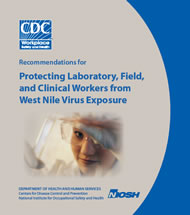
 |
|||
|
NIOSH Publication No. 2006-115:Recommendations for Protecting Laboratory, Field,and Clinical Workers from West Nile Virus Exposure |
December 2005 |
|
This document answers questions about West Nile virus that are relevant to laboratory, field and clinical workers. Recommendations are also included for preventing exposure of these workers to West Nile virus. Contents
| 
|
|||||||||||||||
Recommendations for Protecting Laboratory, Field,and
Clinical Workers from West Nile Virus Exposure
| |||||||||||||||||||||||||||
|
Outdoor, laboratory, field, and clinical workers are at risk of WNV exposure. Although WNV is most often transmitted by the bite of infected mosquitoes, the virus can also be transmitted through contact with infected animals, their blood, or other tissues. Thus laboratory, field, and clinical workers who handle tissues or fluids infected with WNV or who perform necropsies are at risk of WNV exposure. Outdoor workers are at risk of WNV exposure whenever mosquitoes are biting (See Recommendations for Protecting Outdoor Workers from West Nile Virus Exposure NIOSH Publication No. 2005–155. Single copies are available free from NIOSH (1–800–35–NIOSH); or visit the NIOSH Web site at www.cdc.gov/niosh).
Many types of laboratory workers and workers in other occupations may be exposed to WNV. These workers include laboratory diagnosticians and technicians, pathologists, researchers, veterinarians and their staff, wildlife rehabilitators, entomologists, ornithologists, wildlife biologists, zoo and aviary curators, health care workers, emergency response and public safety personnel, public health workers, and others in related occupations.
Workers who handle and process WNV-infected tissues or animals are at risk of infection if their skin is penetrated or cut. Also, anyone who lives or works in areas with WNV-infected mosquitoes is at risk of WNV infection. People of all ages are at risk of the flu-like symptoms of this infection. Although people usually recover, the symptoms may be severe enough to result in lost workdays for extended periods.
People above age 50 and those who have had organ transplants are known to have the highest risk of severe illness from WNV infection. Others with compromised immune systems are also likely to be at high risk. However, people of all ages and conditions can become severely ill. Therefore, ALL workers should be careful to follow the recommendations listed in this brochure to reduce their potential for WNV exposure and infection. When workers are outside, they should also follow the recommendations for outdoor workers.
|
Laboratory workers have been infected with WNV on the job. One case involved a worker whose skin was cut with a scalpel while doing a necropsy of an infected bird. Another worker was infected as a result of a finger puncture with a contaminated needle.
Avoid handling dead animals when possible. If you must handle them, avoid direct contact and wear gloves that provide a protective barrier. See additional recommendations at the end of this brochure.
The Centers for Disease Control and Prevention (CDC) has followed a number of women who became ill with WNV during pregnancy. Most of these women delivered apparently healthy babies with no evidence of WNV infection. Although some of the babies born to WNV-infected mothers did have health problems, it is unknown whether the WNV infection caused these problems. Because of the limited number of cases studied so far, it is not yet possible to determine what percentage of WNV infections during pregnancy result in infection of the fetus or medical problems in newborns. More research is needed to understand the possible effects of WNV on pregnancy.
Pregnant workers should follow the recommendations at the end of this brochure to reduce their risk for WNV infection. When pregnant workers are outside, they should also follow recommendations for outdoor workers, which include avoiding mosquitoes; wearing protective clothing; using repellents containing DEET (N,N-diethyl-m-toluamide), picaridin, or oil of lemon eucalyptus on the skin; and spraying clothes with one of these repellents or permethrin. Always follow label instructions for repellents. Pregnant women who become ill should see their health care providers.
|
The period between exposure to WNV and having symptoms is 3 to 14 days. Testing for WNV infection is available. No vaccine is currently available to prevent WNV infection in humans.
Employers of laboratory, field, and clinical workers should protect their workers from WNV exposure by taking the following steps:
|
Avoid handling dead animals when possible. If you must handle them, take the following precautions:
|
For more comprehensive information about WNV, contact the Division
of Vector-Borne Infectious Diseases, National Center for Infectious Diseases,
Centers for Disease Control and Prevention at
www.cdc.gov/westnile
For further information about occupational safety
and health topics, contact the National Institute for Occupational Safety
and Health, Centers for Disease Control and Prevention at
www.cdc.gov/niosh
For further information about the OSHA Bloodborne Pathogens
Standard, contact the Occupational Safety and Health Administration at
www.osha.gov/SLTC/bloodbornepathogens
For the complete text of the U.S.
Department of Health and Human Services publication Biosafety
in Microbiological and Biomedical Laboratories (4th edition, 1999), see
bmbl.od.nih.gov/
For further information about biosafety, contact
the Office of Health and Safety, Centers for Disease Control and Prevention
at
www.cdc.gov/od/ohs/biosfty/biosfty.htm
This brochure was written by Kathleen MacMahon, DVM, Education and Information Division; and Amanda G. Harney, MPH, Office of Compensation Analysis and Support. Scientists from the Division of Vector-Borne Infectious Diseases, National Center for Infectious Diseases, provided critical input. Susan Afanuh, Anne Hamilton, and Jane Weber provided editorial services. Vanessa Becks provided desktop design and production.